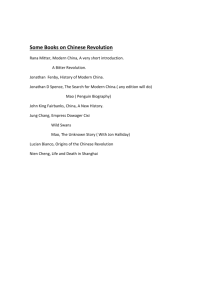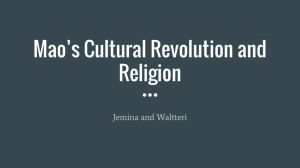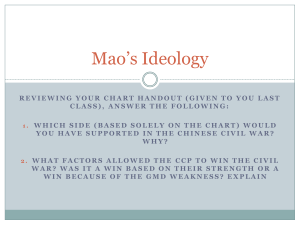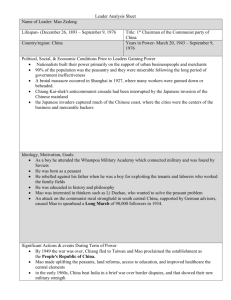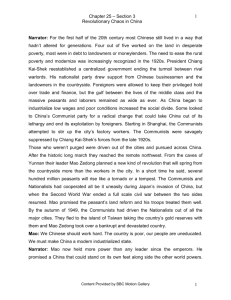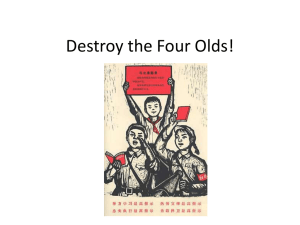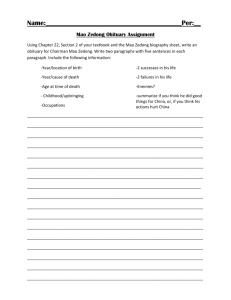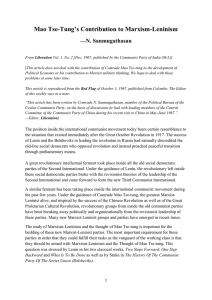China During the Great Proletariat Cultural Revolution
advertisement
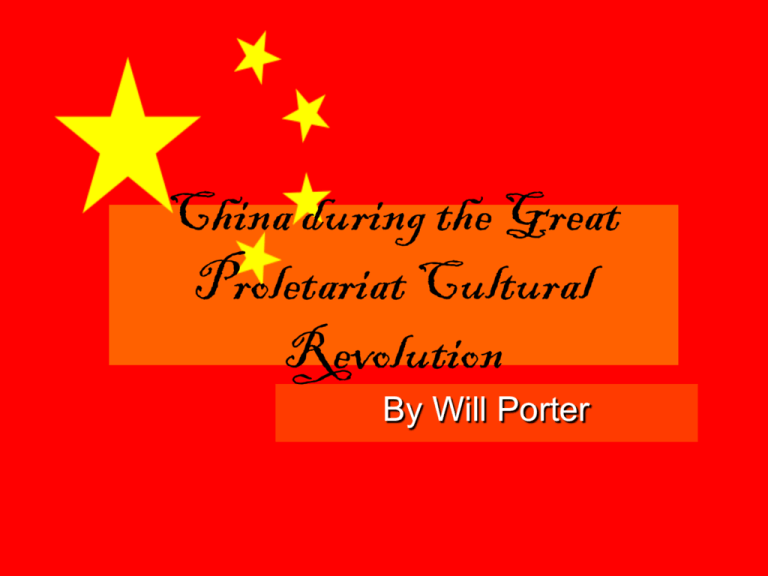
China during the Great Proletariat Cultural Revolution By Will Porter Timeframe The Great Proletarian Cultural Revolution began on May 16, 1966. Led by Mao Tse-tung, it lasted until 1976, although Mao himself declared that it was over in 1969. Location Mao Tse-tung declared China the People’s Republic of China on October 1, 1949. China is located in East Asia and borders the Yellow Sea, the East China Sea, Mongolia, India, and many other nations. The Chinese consider Taiwan to be part of China and call it the Republic of China. A New Culture The Cultural Revolution, was just that, a change in the Chinese culture. However, this revolution was government sponsored, as Mao sought to eliminate bourgeoisie intellectuals from China, and create a powerful, single-class, proletariat country. The Youth Movement Instead of killing the intellectuals in China, who amounted to less than 10% of the population, Mao decided to re-educate intellectuals in the ways of the proletariat. To do so, he made many books and learning sources illegal, and relocated members of the bourgeoisie class to farming communities where they were forced to do manual labor. http://www.youtube.com/watch?v=QbECxnd5ZA4 Literature During the Cultural Revolution, almost all forms of creative literature were made illegal. All western books were banned and destroyed, and no one was able to publish any literature unless it supported the Communist National Party. Mao Tse-tung published many works himself, and almost everyone in China was forced to carry around a book of his quotations known as the “Little Red Book.” Music Music, like all other forms of art, only existed in the form of propaganda. Typical songs were titled “The East is Red,” “Long Live Chairman Mao,” and “I Love Beijing's Tiananmen.” This song is entitled, “I am a Little Member of the Commune.” I am a little member of the commune, with a little sickle in my hand, and a bamboo basket on my shoulder. I go to work after class, cutting weeds, collecting manure, and picking up the lost wheat ears. The more I work, the more I love it. Ayh-hey-hey, Aye-hey-hey, Always keeping in mind the good character of the poor-and-lower-middle peasants, Loving the collective and loving labor, I am a little member of the commune! Art At one point in China calligraphy had been considered the greatest form of art above painting and dancing. The Chinese language consists of 60007000 characters, each with an intricate design. During the Cultural Revolution, all forms of art, calligraphy, painting, dancing, and singing, were reduced to those that supported the Communist National Party. “Let the new Socialist Performing Arts conquer every stage.” Etiquette The Three Main Rules of Discipline are as follows: (1) Obey orders in all your actions. (2) Do not take a single needle piece of thread from the masses. (3) Turn in everything captured. Religion Mao lashed out at organized religion in China. He blamed religion for China’s problems and under his rule many different types of temples and churches were burned to the ground or converted into government buildings. However, some people began to worship Mao, and Mao worship evolved into a cult activity. People Over 90% of all of the people in China belonged to the proletariat class. These were countryside farmers who lived in small farming communities. People would farm for both sustenance and local sales, and sometimes meat was hard to come by in certain locations. Women Before Mao, women had been treated as subservient in China. However, Mao insisted on treating women as equals saying “Women hold up half the sky.” “Proletarian revolutionary rebels unite!” The End Thank you for always thinking of Mao.
